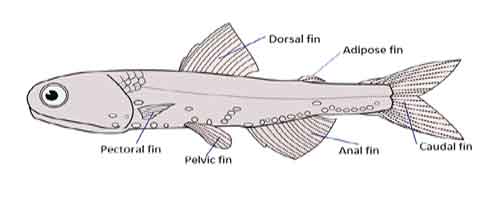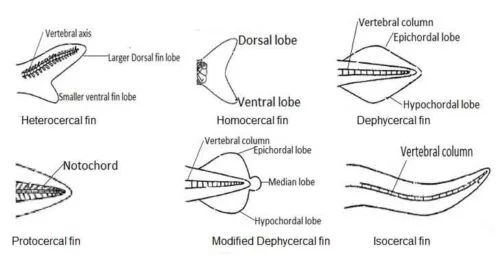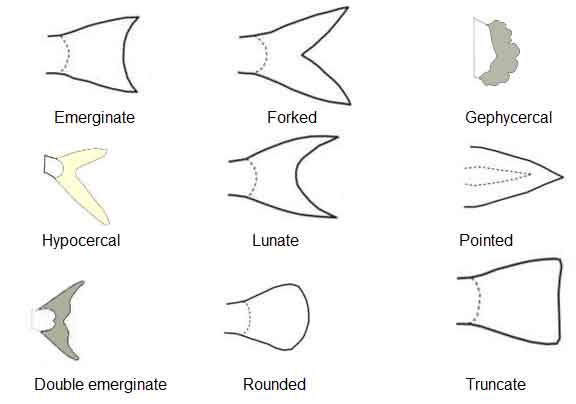Fins are one of the most distinguishing features of a fish and they have several different forms. Two types of fins are found in most of the fish: median and paired fins. Median fins are single in number which runs down the mid-line of the body. In fishes, median fins are dorsal, caudal and anal fins while paired fins are pectoral and pelvic which are arranged in pairs homologous to human arms and legs. Fins help to swim and maintain the balance of the body. Fins also help to identify the fish species. Different types of median and paired fins are described below:

Dorsal Fin
This type of fin is located on the top or back of the fish which help the fish in quick turns or stops. It also helps the fish against rolling. In fish, there are three distinct dorsal fins such as proximal, central or middle, and distal dorsal fins. Some fish have two dorsal fins where the central and distal fins are combined together.
The Types of Dorsal Fins
• Single
• Pointed
• Split
• Spine triangular
• Trigger
• Trailing
Lowrance Elite FS 7 Fish Finder
Pelvic Fin
In fishes, a pair of pelvic fins are present which are located ventrally below and behind the pectoral fins. In some fishes, they are situated in front of the pectoral fins (Cod family). This type of fin helps in stability and slowing down the fish. Generally, fish use pelvic fins for moving upwards and downwards in the water.
Anal Fin
The Anal fin is also known as cloacal fin which is located on the ventral side just behind the anus. It supports the dorsal fin and stabilizes the fish during swimming and contrinols the rolling motion.
Pectoral Fin
Pectoral fins are located on both sides usually just behind the operculum. It is homologous to the tetrapod`s forelimbs. It provides supports during swimming. It creates dynamic lifting force and also helps the fish to turn left or right.
Adipose Fin
They are soft fins and located between the dorsal and caudal fins, usually very near to the caudal fin. It is mainly found in Salmonidae, Characins, and catfishes. This type of fin help to navigate the fish in rough water.
Caudal Fin
The caudal fin is the primary appendage which is used for locomotion in many fishes. The caudal fin is also known as tail fin or a median fin which is usually homocercal or heterocercal. Generally, it is a vertically expanded structure which is located at the caudal end of the body. The base of the caudal fin is known as caudal peduncle with strong swimming muscles. In general, caudal fin acts like a propeller while the caudal peduncle functions as a motor.
The caudal fin has two lobes such as dorsal epichordal and ventral hypochordal lobe which are supported by the modified last three caudal vertebrae. The shape of the caudal fin may vary in different species from rounded to pointed, notched, emarginated, truncated, etc. It is used to identify the fish species. Generally, fish use it for forwarding propulsion and speed.
The caudal fin of the adult fishes may be grouped into three categories:
Protocercal Caudal Fin
It is the most primitive type of caudal fin where the straight vertebral column divides the caudal fin into two equal lobes such as upper lobe and lower lobe. In this case, the upper lobe is known as epichordal or epicaudal and the lower lobe is called hypochordal or hypocaudal lobe. A series of rods are arranged around the central axis of the caudal region, which support the fin membrane. Undoubtedly, during the developmental period, the caudal fin of all fishes passes through the protocercal stage. This type of fin is found in cyclostomes and the living dipnoans(lungfishes).
Heterocercal Caudal Fin
The heterocercal tail is sometimes called the shark-tail type of caudal fin. Elasmobranch (cartilaginous fish) and some primitive type of bony fishes contain this type of fin. This fin has two unequal lobes where the upper smaller lobe is known as epichordal lobe and a much larger lower lobe is known as hypochordal lobe. In this case, the hind end of the vertebral column becomes bent upwards and continues almost up to the tip of the fin.
Homocercal Caudal Fin
Most of the higher teleosts have homocercal caudal fin. It has superficially symmetrical and two equal sized lobes such as upper epichordal and the lower hypochordal lobe. Internally, this tail is asymmetrical and the hinder end part of the vertebral column is greatly shortened and turned upward. In this case, the vertebral column does not touch the posterior limit of the fin.

Varieties of Caudal Fins
The internal and external structure of caudal fin varies which depends on the swimming habits of the fish. Generally, these variations involve special modification of the vertebral column. Following seven main types of caudal fins are found in fishes:
- Lunate or Crescentic: It is used for Continuous long distance swimming. e.g. Tuna
- Forked: It is used for rapid swimming, e.g. Herring, Mackeral.
- Emarginate: e.g. Trout, Carp, Perch.
- Truncate: It aids in turning quickly. e.g. Flounder
- Rounded: It is used for slow swimming, accelerating, and maneuvering. e.g. Turbot and Lemon-Sole.
- Pointed: e.g. Gobby
- Double emarginate

Modifications of Caudal Fin
Many fishes have specialized modified types of caudal fins such as:
Many fishes have specialized modified types of caudal fins such as:
- Isocercal or leptocercal
- Internally symmetrical Caudal Fin
- Pseudocercal Caudal Fin
- Hypocercal Caudal Fin
- Gephyrocercal Caudal Fin
(1) Isocercal or Leptocercal
In some fishes, tapering and symmetrical types of fin is present which is known as isocercal or leptocercal caudal fin. In this case, the spine is long with a straight rod-like structure. Rat tails (Macruidae), Blennies (Blennidae) Eels (Anguilliformes), feather backs (Notopteridae), and Gymnarchids (Gymnarchidae), etc have the isocercal caudal fin.
(2) Internally Symmetrical Caudal Fin
This is a reduced type of caudal fin where some fin elements are fused together. They are found in cods (Order: Gadiformes).
(3) Pseudocaudal Caudal Fin
In the modern lungfishes (Dipnoi), the pseudocaudal caudal fins are found. In this case, fins are developed from the backward growth of dorsal and ventral elements.
(4) Hypocercal Caudal Fin
This type of caudal fin bears much larger dorsal lobe than the ventral lobe which is greatly reduced. They are found in certain early Agnathans. It is also known as inverted heterocercal caudal fin. In this case, the vertebral axis turns downwards sharply where the lobe develops from its upper surface.
(5) Gephyrocercal Caudal Fin
It is a very specialized type of caudal fin which is also known as bridge caudal fin. Generally, they look like the isocercal fin but the fins are reduced to vestiges. In this case, the caudal lobe is truncated where hypurals of the spinal column are lacking. These types of fins are found in the pearlfishes (Carpus), Flerasfer and Orthagoriscus.
Garmin Striker Vivid 9sv Fishfinder and Sonar Transducer
Functions of Fins
Fish use their fins for various purposes. Some important functions of fins are described below:
- Generally, the pectoral fins help a fish for turning.
- Some bony fishes use their pectoral fins to help them rest on the bottom or on reef areas (e.g. Cirrhitichthys).
- Mudskippers (Periophthalmidae family) use pectoral fins for supporting themselves on land.
- Flying fish (Exocoetidae family) use their long pectoral fins for gliding over the water.
- Pectoral fins of some bottom-residence fishes such as threadfins (Polynemidae) bear touch receptors and taste buds which help to trace food.
- Pelvic fins help the fish stability in the water.
- Pelvic fins of some fishes such as clingfishes (family Gobiesocidae) use as sucking appendage, which helps a fish hold on to stationary objects on the ocean bottom.
- Most of the bony fishes use their dorsal fin for sudden direction changes.
- Dorsal fins act as a ‘keel’ for keeping the fish stable in the water.
- Some angelfishes (Lophiiformes) use their dorsal fin as a lure which helps to attract the prey.
- The modified dorsal fin of some fishes (Echeneidae) use as a sucking disc.
- African knife fish (Gymnarchus niloticus) use its dorsal fin to move forward or backward by creating undulating.
- Most of the bony fish use their caudal fins for propulsion.
- Lunate caudal fins are characteristic features of fast swimmers such as tunas. They use it for maintaining rapid speed for long duration..
- Anal fins make stability and anal fins of some bony fishes help in reproduction.
- Sea Robin fish use their pelvic fin for walking along the substrate.
- Some fishes such as Freshwater butterflyfish (Pantodon buchholzi) use their pelvic fins for gliding.
- Sea Robins use their pectoral fin for gliding around in the currents.
- Lionfish and other scorpionfish have dorsal fins with hollow venomous spines which are used for self-defense.

